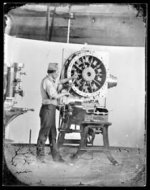This looks like a good place to say that I've heard an unverified legend that the Morse Tapers were all supposed to be the same taper per foot, but they ended up the way they are because a set of gages provided to a U.S. government arsenal by Morse was defective. For some reason, Morse felt they had to provide product to Uncle Sam which matched the gages they'd sent, rather than recall the gages.
The Morse Tapers lack mathematical consistency. This is the only remotely plausible explanation I've seen for that.
Can anybody show me an at least semi-authoritative, at least semi-contemporary reference for this legend?
John Ruth
Who thinks Morse erred and became a widespread standard, while Jarno got it right but languished in relative obscurity!
I will try to address this and Joe's reference to the "American Taper".
I have always been interested in early tapers for machine tools, especially milling and drilling machines.
One thing you have to understand is what the taper is being used for, ie, for milling, drilling or lathe centers.
You also have to remember the time frame for Morse tapers(mid 1860's to early 1870) and the machine tools and gauging equipment available at that time.
I would not say that Morse erred and Jarno got it right. Jarno came well after Morse when gauging equipment was far better.
The "unverified legend" is not entirely correct.
A few of us, on the PM, email each other on old machine tools. Last night I sent out a lot on Morse with links. enginebill has posted one of those links.
I was doing research on Morse again and the Manhattan Fire-Arms Co. taper. Still trying to find the large and small end dimensions for the Manhattan taper, which would become the American taper.
First here is a link to an American Machinist article in 1884 showing Morse taper dimensions, which they got from Morse.
American machinist. v.7 1884. - Full View | HathiTrust Digital Library | HathiTrust Digital Library
At that time they believed these were measured correctly, but of course were not.
This spurred some more articles in 1885 American Machinist.
Letter to American Machinist from George Stetson, Superintendent of Morse Twist Drill.
Note that this letter also explains how the No.6 taper came about.
American machinist. v.8 1885. - Full View | HathiTrust Digital Library | HathiTrust Digital Library
Another one from 1885.
American machinist. v.8 1885. - Full View | HathiTrust Digital Library | HathiTrust Digital Library
One more from 1885, with a response from George Stetson.
American machinist. v.8 1885. - Full View | HathiTrust Digital Library | HathiTrust Digital Library
From 1896 when Morse found they had not measured the tapers correctly back in the 1870's.
American machinist. vol.19 (1896). - Full View | HathiTrust Digital Library | HathiTrust Digital Library
Morse knew about the errors in the taper per foot between the tapers back in the early 1880's.
They cited the gauging equipment and machines at the time for the error.
They thought about changing it but it was in such widespread use that they decided to leave it alone.
They thought that changing it would bring about more confusion.
This was from an article in a British publication by George Stetson.
Most people today believe that all of the Morse tapers were to be 5/8" to the foot, but this is wrong.
In the above articles George Stetson said the 5/8" had been departed from.
There was a problem then, which we still have today, called pull out.
This is when a drill bit comes thru the other side of the hole being drilled.
It likes to grab and pull. If the work piece is not clamped, it likes to pull the work up.
If the work piece is clamped, then the drill bit likes to pull down and if there is any slack in the drill spindle it will pull even harder.
This sometimes results in the drill bit pulling out of the Morse socket.
This was a big problem on the smaller drill bits, but not as much on the larger drill bits.
They found out that by making the taper per foot less than 5/8", that it would greatly reduce the pull out.
Morse decided to make the smaller tapers(1,2,3) .600 taper per foot and keep the larger tapers(4 & 5)at 5/8". At that time 0, 6 & 7 did not exist.
Morse had a competitor in the early years for both drill bits and the taper used for drill bits.
This was the Manhattan Fire-Arms Co. They made guns and drill bits. Their taper was called the "Manhattan Taper".
Later, Manhattan would reorganize as the American Standard Tool Co. Still making guns and drill bits.
Their taper would then be known as the "American Standard Taper", which would be shortened to the "American Taper".
Manhattan had the same problem with pull out. They decided to use 9/16" taper per foot on their smaller tapers and 5/8" taper per foot on their larger tapers.
This will explain the taper on Joe's lathe.
Stephen Morse went to work for the American Standard Tool Co. after he left Morse Twist Drill & Machine Co.
Some of his patents are assigned to the American Standard Tool Co.
Eventually Morse Twist Drill would buy the drill business of the American Standard Tool Co.
Morse continued to offer the "American Taper" for awhile and then phased it out.
Stephen Morse would go on to start an elevator company in Philadelphia. He has many patents for elevators.
Stephen Morse retired from his elevator company in 1891 and died in 1899.
Here is a picture I have of the Morse Twist Drill employees in the 1880's.
Also an ad showing Stephen Morse working for American Standard Tool, and elevator ads.
Rob









